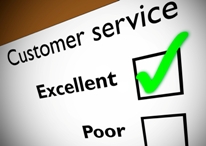Advertising disclosure: This blog participates in the Amazon Services LLC Associates Program, an affiliate advertising program designed to provide a means to earn fees by linking to Amazon and affiliated sites.
A healthcare CEO recently wrote to me with a question about incentives.
He had read The Service Culture Handbook, and was surprised that I did not include a section on incentivizing employees to align with the culture. The CEO was looking for resources to motivate and reward his team.
A lot of leaders have this same question. My advice is surprising.
A rewards program is a very bad idea.
Employees don't need to be motivated.
Recognition can be helpful, if you do it right.
I've covered this topic in previous posts, so here are a few links if you'd like a refresher:
It's important to note that none of the customer-focused companies I researched for The Service Culture Handbook emphasized rewards to incentivize employees. Recognition, however, often does play a role.
This post focuses on the critical difference between those two terms: rewards and recognition.
What are employee rewards?
Rewards and recognition often get conflated, but they're really two different concepts. Recognition can be useful if done correctly, but rewards generally cause harm.
Here's a definition of rewards from my book, Getting Service Right:
Rewards are if-then propositions that are designed to incentivize employees to engage in certain behaviors. The actions or results required to earn the reward are spelled out ahead of time so employees know how to win the prize.
Examples of rewards I've seen customer service leaders use include:
Cash incentives for earning good survey scores.
Contests to see who can reply to the most emails.
Prizes for getting good mystery shopper results.
Games where employees can earn badges for completing training modules.
Company swag for achieving perfect attendance for a month.
Rewards typically cause two big problems.
The first is rewards can diminish employees' natural motivation. Offer a $100 gift card for good survey scores one month, and employees will come to expect a $100 gift card for good survey scores going forward.
The second problem is even worse. Rewards often incentivize the wrong behaviors. For example, offering a reward for good survey scores often leads to manipulated survey results, not better service.
What is employee recognition?
Recognition can be very helpful, if used correctly. Here's a definition from Getting Service Right:
Recognition is given when an employee does something positive as a way of encouraging the employee to repeat the behavior. It can be something tangible—like a gift card or a day off—or something intangible, such as praise from the boss or an employee-of-the-month award. Unlike rewards, the path to earning recognition isn't shared with employees beforehand. It's an unexpected surprise for a job well done.
Examples of recognition I’ve seen customer service leaders use include:
Praise for helping an upset customer.
A gift card as a thank you for solving a tough problem.
Lunch for the team to celebrate a successful project.
A “wall of fame” where positive customer feedback is displayed.
Company swag to commemorate a big accomplishment.
Unlike rewards, recognition is difficult to game. That’s because it happens after the behavior occurs and is not predictable. Used in this way, rewards are a clear signal to employees that their performance is valued.
Customer-focused companies I've studied often use peer recognition programs where employees are recognized by coworkers for outstanding contributions.
Infographic
In summary, rewards often promote unhealthy behaviors while recognition encourages employees to continue positive behaviors.
Here's an infographic you can use to share this concept.




